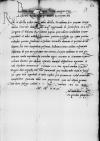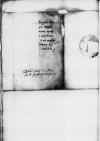List #491
Bona Sforza do Ioannes DANTISCUSCracow (Kraków), 1530-05-07
| odebrano Innsbruck, [1530]-06-16 Rękopiśmienne podstawy źródłowe:
| ||||
Tekst + aparat krytyczny + komentarz Zwykły tekst Tekst + komentarz Tekst + aparat krytyczny
Reverendo in Chris paper damaged⌈[Reverendo in Chris]Reverendo in Chris paper damaged⌉to Patri, domino Ioanni Dant paper damaged⌈[Ioanni Dant]Ioanni Dant paper damaged⌉isco, electo episcopo Cul paper damaged⌈[episcopo Cul]episcopo Cul paper damaged⌉mensi apud caesaream e paper damaged⌈[caesaream e]caesaream e paper damaged⌉t catholicam maiestatem regio paper damaged⌈[maiestatem regio]maiestatem regio paper damaged⌉ et nostro nuntio ac oratori paper damaged⌈[ac oratori]ac oratori paper damaged⌉ sincere nobis dilecto
Reverende in Christo Pater, sincere paper damaged⌈[ere]ere paper damaged⌉ nobis dilecte.
Recoluimus his proxime elapsis diebus binas nos dedisse litter paper damaged⌈[e litter]e litter paper damaged⌉as magnifico
Et bene feliciterque valeat S(inceritas) or S(trenuitas)⌈S(inceritas)S(inceritas) or S(trenuitas)⌉ Tua.
Dat(ae) or Dat(um)⌈Dat(ae)Dat(ae) or Dat(um)⌉
Ad mandatum s(acrae) or s(erenissimae)⌈s(acrae)s(acrae) or s(erenissimae)⌉ maiestatis reginalis proprium


 BCz, 3465, p. 28
BCz, 3465, p. 28